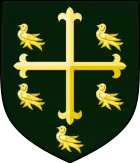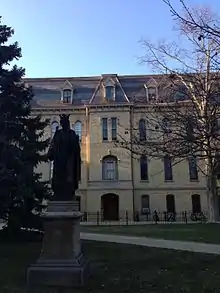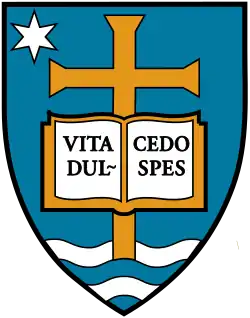St. Edward's Hall (University of Notre Dame)
St. Edward's Hall is one of the 32 Residence Halls on the campus of the University of Notre Dame and one of fifteen male dormitories. Saint Edward's Hall is located directly east of the Main Administration Building and is directly west of Zahm Hall. Saint Edward's Hall (also referred to as "St. Ed's" or "Steds") houses 162 undergraduate students. It is, together with other historical structures of the university, on the National Register of Historic Places.[2] The coat of arms is the Cross of Saint Edward the Confessor on a green background.[3]
| St. Edward's Hall | |
|---|---|
| University of Notre Dame | |
 | |
| Campus quad | Main |
| Motto | For Hall and King |
| Established | 1929, built 1882 |
| Colors | Green and Gold |
| Gender | Male |
| Rector | Rev. Ralph Haag, C.S.C. |
| Undergraduates | 161 |
| Chapel | St. Edward the Confessor |
| Mascot | Gentlemen, Stedsmen, Big Cats |
| Interhall sports | Baseball, Basketball, Bowling, Cross Country, Dodgeball, Football, Golf, Hockey, Lacrosse, Racquetball, Soccer, Table Tennis, Tennis, Ultimate Frisbee, Volleyball |
| Charities | Lakeview High School, Jinga, Uganda |
| Major events | Founder's Week, Yacht Dance, Mullets Against Malaria |
| Website | steds |
St. Edward's Hall | |
 | |
| Location | Notre Dame, Indiana |
| Coordinates | 41°42′12″N 86°14′17″W |
| Built | 1882[1] |
| Architect | Father Edward Sorin and Brother Charles Harding[1] |
| Architectural style | Collegiate Gothic |
| Part of | University of Notre Dame: Main and North Quadrangles (ID78000053) |
| Added to NRHP | May 23, 1978 |
History

Matthew J. Walsh decided to build Saint Edward's Hall in 1882 to house the boarding school for the minims program, ages six to thirteen, which was growing and reached a population of a 100 in 1883. The hall was designed by Charles Harding, C.S.C, in Notre Dame yellow brick in French style, with a Mansard roof and named after Edward Sorin's patron saint.[4] The cornerstone was laid on 20 April 1882 by Sorin himself. It had dormitories, classrooms, recreation rooms, refectory, and a manicured lawn in front of the building. An annex was built on the east side of the hall in 1898 to make room for a gym, a roller skating rink, and more classrooms. In 1925, Knute Rockne received his First Holy Communion in the Chapel of Saint Edward the Confessor.[5] In 1929 president Charles L. O’Connell decided to abandon the boarding school program, and the hall was converted into an undergraduate residence hall (since the college population was growing and space badly needed) under the direction of professor and architect Vincent Fagan in June 1929.[6] The open dormitory was converted into double rooms, while the chapel was left untouched, and it opened in Septepmber to house 207 undergraduates.[7] The hall's first rector was Raymond Clancy, C.S.C.[8] The building annex was demolished to make space for Zahm Hall in 1937. The facade received minor renovations in 1976. Disaster struck on 25 June 1980 when a fire broke out resulting in extensive damage. In the summer of 1980, the third and fourth floors of the building caught fire and were heavily damaged but have since been rebuilt. Saint Edward's Hall's signature annual event is Founder's Day and Founder's Week. It is celebrated during the week of October 13 and it includes a 3-on-3 basketball tournament, historical lectures, talent show, and a special dormitory Mass. There is also an annual Spring excursion to Chicago, the Yacht Dance, in which the Gentlemen take part in a dance aboard a chartered yacht. St. Ed's main dorm rivalry is with Sorin Hall.

Distinguishing features
The Chapel of St. Edward the Confessor contains eight stained glass windows depicting various saints, Saints Edward, Anthony, and Andrew, while the other five show scenes from the life of Jesus. The glass was produced by the Carmelite stained glass atelier in Le Mans. Two were designed by Eugène Hucher and sons studios 1888 and four by his student Albert Echivard in 1912. The same French company also completed a large stained glass portrait of the University's founder Father Edward Sorin, which is found in the central stairwell. In addition, St. Edward's second floor has a mural by the Vatican muralist Luigi Gregori, whose work also adorns the Main Building, and the Basilica of the Sacred Heart. The mural depicts a meeting between Father Sorin and the local Native Americans at the founding of the University in 1842. The residence hall is the oldest building on campus currently in use as an undergraduate dormitory, and its original wing is constructed of the signature yellow bricks dredged by Holy Cross religious from the marl found in the University's two lakes.
Rector
Fr. Ralph Haag, C.S.C., is the current rector of Saint Edward's Hall.
- Stained Glass Windows in St. Edward's Hall
.JPG.webp) St Edward
St Edward.JPG.webp) St Andrew
St Andrew.JPG.webp) Young Christ
Young Christ.JPG.webp) Mary
Mary.JPG.webp) Jesus
Jesus.JPG.webp) St Joseph
St Joseph.JPG.webp) St Louis
St Louis.JPG.webp) St John
St John
Notable residents
- John Carlson - Arizona Cardinals tight end
- Jimmy Clausen - Notre Dame football quarterback
- Pat Connaughton - Milwaukee Bucks shooting guard
- Phil Donahue - talk show host
- Ryan Grant - Green Bay Packers running back
- Tim Grunhard - Kansas City Chiefs center
- Dan Hesse - CEO of Sprint
- Paul Hornung - Heisman Trophy winner
- Sadoluwa "Dolu" Lanlehin - Nigerian prince
- Chris Thomas - professional basketball player
- Monty Williams - professional basketball player/coach
Notes
- "Official Building Inventory" (PDF). Facilities Design and Operations. University of Notre Dame. 1 October 2015. Retrieved 11 November 2015.
- James T. Burtchaell (November 1976). "National Register of Historic Places Inventory/Nomination: University of Notre Dame Campus-Main and South Quadrangles" (PDF). Indiana State Historic Architectural and Archaeological Research Database and National Park Service. Retrieved October 18, 2017. With seven photos from 1972-76. Map of district included with text version available at National Park Service.
- "The Gentlemen's Monthly". stedwardshall.blogspot.com. Retrieved 2020-10-22.
- Hope, CSC, Arthur J. "Notre Dame: St. Edward's Hall". Notre Dame One Hundred Years. University of Notre Dame Archives. Retrieved 15 May 2014.
- McMahon, John. "The Day the Rock was Baptized at the Log Chapel". The Spirit of Notre Dame. Dorothy V. Corson. Retrieved 15 May 2014.
- Alumnus (PDF). 8 (1). September 1929 http://www.archives.nd.edu/Alumnus/VOL_0008/VOL_0008_ISSUE_0001.pdf. Retrieved 29 March 2019. Missing or empty
|title=(help) - Alumnus (PDF). 8 (1). September 1929 http://www.archives.nd.edu/Alumnus/VOL_0008/VOL_0008_ISSUE_0001.pdf. Retrieved 29 March 2019. Missing or empty
|title=(help) - "ST. EDWARD'S HAUL HOLDS FIRST SMOKER" (PDF). Scholastic. 63 (5). October 18, 1929. Retrieved 29 March 2019.
References
- Eloi Rylan, Koios (2011). Saint Edward's Hall (1st ed.). Tract. ISBN 9786139394326.
- Irish Legends
- St. Edward's Hall Profile
- Notre Dame Magazine - Hall Portrait: Saint Edward's
